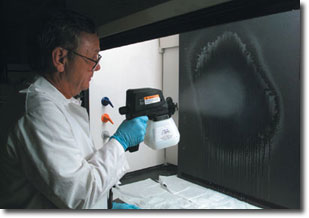NAS study looks at safety of reopening public facilities after a biological attack
 (Download Image)
Livermore chemist Mark Hoffman uses a household paint sprayer to apply L-Gel to a test panel. L-Gel is a compound developed at Livermore that has proven effective at decontaminating all classes of chemical warfare agents as well as surrogates for biological warfare agents.
(Download Image)
Livermore chemist Mark Hoffman uses a household paint sprayer to apply L-Gel to a test panel. L-Gel is a compound developed at Livermore that has proven effective at decontaminating all classes of chemical warfare agents as well as surrogates for biological warfare agents.
LIVERMORE, Calif. — In an effort to provide a framework for decontamination of public facilities and other buildings in the wake of a biological attack, a National Academy of Sciences report calls for improved risk assessment models to determine the effectiveness of cleanup, as well as when a building is considered "safe" for reoccupation.
The study, "Reopening Public Facilities After a Biological Attack: A Decision-Making Framework," was put together at the request of Lawrence Livermore National Laboratory and the Department of Homeland Security. The academy's National Research Council convened a committee of experts to consider the criteria that must be met for cleanup of a biologically contaminated area to be declared successful, thus allowing reoccupation of the facility.
"The more prepared we are to respond to a biological attack, the greater the chance we have to prevent that from happening," said Ellen Raber, who heads up the Laboratory's Environmental Protection Department and served as the principal investigator for the report.
"Following the anthrax attacks in 2001, it became clear we had no real way of determining how clean is clean enough," Raber said. "Determining just how ‘safe’ is clean is the reason behind this report. It provides a framework for thinking about issues that must be considered in the decision to reopen a facility after an attack."
The report is a $1-million, two-year effort conducted by a prestigious committee of biosafety experts, research scientists, medical consultants and environmental experts. Ken Berns, of the University of Florida, chaired the committee. LLNL scientists presenting to the committee included Raber, Dennis Imbro, Ray Mariella, Kimothy Smith and Tina Carlsen.
The committee heard key briefings from interagency players, including the Environmental Protection Agency, the Centers for Disease Control, the Department of Defense and others. The committee was asked to assess risk for various amounts of residual contamination from agents such as plague, anthrax and smallpox in various public facilities, including airports.
The report concludes that current data are insufficient to determine correlations. More research on dose-response relationships would allow scientists to narrow the uncertainty associated with the risks. However, even with improved correlations, the decision to reopen a facility is a complex issue that involves social decisions about what constitutes "safe."
Raber said the report did not plan to address in any detail the risk that such an attack will occur, the effectiveness of emergency response to the attack, the identification of the appropriate allocations of research or response, or broader public health issues related to transmissible diseases. It does not recommend specific decontamination technologies. Instead the report reviews the key factors that influence decision-making and lays the foundation for establishing standards and policies for relevant aspects of decontamination.
Raber said the report should serve as a resource to help all decision makers understand the relevant concerns and come up with effective responses to key public health and environmental concerns. The report concludes that more research on dose-response relationships would allow scientists to narrow the uncertainties associated with health risks. The report has two major conclusions:
- " Infectious doses for harmful biological agents that can be used as weapons cannot be determined with confidence because the infectivity and virulence of harmful agents can vary by strain, within species, and by type of preparation for weapons. Currently available data on dose-response relationships are not as detailed as demanded by modern scientific standards, in most cases covering only exposure in young healthy adults."
- " There is insufficient information on which to base ‘safe’ numbers of residual biological agents for a decontaminated facility. Further research could provide additional information on infectious dose that would decrease the uncertainties and make a quantitative approach more useful. However, the risk different people or groups of people are willing to tolerate will always vary."
The report also stresses preparedness plans for key transportation facilities and identifies key scientific areas where future investments can increase public safety.
"Through this report we now have a greater understanding of where the problems lie and what we need to do to address them," said Elizabeth George, deputy director for Biological Countermeasures, Department of Homeland Security. "The report provides 50 recommendations that can be evaluated and prioritized to increase public safety. It is an excellent evaluation and resource of what we know today and what we need to build on for the future."
The National Research Council report is available on the NAS public Website .
Founded in 1952, Lawrence Livermore National Laboratory has a mission to ensure national security and to apply science and technology to the important issues of our time. Lawrence Livermore National Laboratory is managed by the University of California for the U.S. Department of Energy's National Nuclear Security Administration.
Contact
Lynda Seaver[email protected]
925-423-3103
Related Links
“Reopening Public Facilities After a Biological Attack: A Decision-Making Framework”“L-Gel Decontaminates Better Than Bleach”




